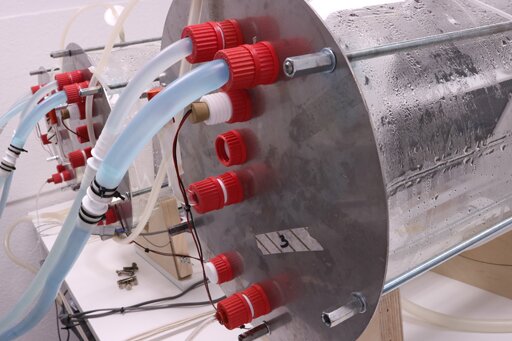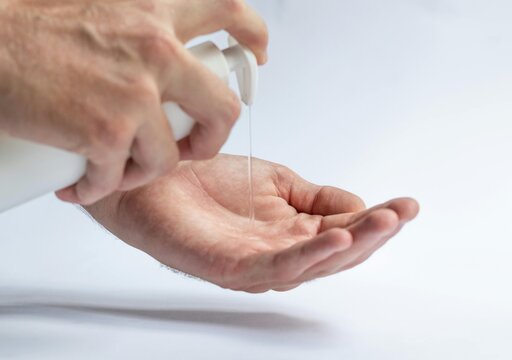
Biocidal products are regulated under the EU Biocidal Products Regulation. This sets high regulatory hurdles for biocidal products. We are aware of these challenges and therefore offer one-stop efficacy tests for product types 1 to 12 as well as 21 against all target organisms including viruses, bacteriophages, bacteria and fungi, e.g., according to EN 14885, VAH, ASTM, AOAC. If there are no standardized procedures for your special preparation yet, we will develop suitable procedures together with you and in coordination with the authorities. Of course, we are accredited by the DAkkS for all test methods according to ISO/IEC 17025 and GLP-certified. We are always at your side, with the highest quality "Made in Germany" and many years of experience.
Disinfectants
Efficacy testing - EN 14885
For the purpose of European approval, chemical disinfectants containing biocides require, among other things, effectiveness tests according to international standards, which we as a testing laboratory are happy to carry out for you.
We at Dr. Brill + Dr. Steinmann not only test your finished biocidal product, but are also happy to accompany you in testing biocidal active ingredients or various formulations on the way to the finished product. We are happy to support you with cornerstone tests, screenings and full tests, suspension tests, carrier tests as well as practical tests and field studies against all target organisms (bacteria, viruses, fungi, bacterial spores, bacteriophages, mycobacteria and algae) from a single source so that you can successfully achieve your goal.
For this purpose, we offer all EN standards according to EN 14885 such as EN 13727, EN 13624, EN 14476, EN 17126, EN 14348, EN 16777, EN 16615, EN 17430, EN 1500, EN 1499, EN 12791, EN 13697, EN 17387 , EN 16616, EN 17272, EN 17211, EN 17422, EN 14561, EN 14562, EN 14563, EN 13610, 13623, EN 1276, EN 1650, EN 13704, EN 16437, EN 16438, EN 14349.
If you are unsure which test is right for your product, we are happy to help you.

Disinfectants
Efficacy testing - VAH
Anyone who deals with the marketing of chemical disinfectants and biocides for the healthcare sector will inevitably come across the VAH listing process in Germany. We would be happy to offer you the right package of tests to suit your question.
You can choose from classic VAH methods (e.g. methods 7 to 19 and V1A to V4A).
However, we recommend basing this on EN methods recognized by the VAH (e.g. EN 13727, EN 13624, EN 1499, EN 1500, EN 12791, EN 17387, EN 1716, EN 16615, EN 14561, EN 14562, EN 14563, EN 14348, EN 16616, EN 14476, EN 16777, EN 17111, EN 17430).
But if you would like to find out more about the requirements in Germany in advance, you will find some useful tips in the adjacent video .
Disinfectants
Efficacy testing - AOAC & ASTM
As a testing laboratory, we are interested in offering our customers the broadest possible portfolio of standards. A number of US standards have therefore been established that are required when products are approved, particularly by the US EPA and US FDA. These include, among others:
- AOAC (e.g. 955.14, 955.15, 955.17, 964.02, 991.47, 991.48, 991.49) and
- ASTM (e.g. E1153-14, E1174-13, E1839-13, E2197-17, E2755-15, E1052-20, E1838-1, E2011-13, E1053-20)
Disinfectants
Efficacy testing - antimicrobial surfaces
Do you have a product that is intended to protect a surface from growth or proliferation of microorganisms? We at Dr. Brill + Dr. Steinmann also have standardized tests in our program for this application, which can provide you with information about the effectiveness of your product. This includes:
- ISO 22196, ISO 21702, ISO 18184, ISO 7581, ISO 20743
- PAS2424
If you are unsure about the specific advantages and disadvantages of the respective processes in relation to your product, our team will be happy to help you.
Disinfectants
Efficacy testing - projects
Does your interest go further than a classic norm can achieve? Are you interested in innovative scientific questions about the effectiveness of your disinfectant (for example for publication or marketing purposes) and would you like to investigate this with a test that is not based on international standards? We have that too at Dr. Brill + Dr. Steinmann in the program. Our expertise focuses, among other things, on:
- Biofilm models
- Wound models
- Phase 3 studies and field studies
- various methods established in house
Thanks to our internal service facilities, company branches and partners, we can also work on top current and exciting topics with you!

Disinfectants
Efficacy testing - biofilms
The fight against biofilms is a major challenge for many manufacturers of biocidal products given regulatory uncertainties on the one hand and technical hurdles on the other. We at Dr. Brill + Dr. Steinmann however, through the development and establishment of various models with regard to biofilms, have a great deal of expertise that you can draw on. Benefit from various technical options that can provide useful insights in the context of biofilms. Among other things, we can offer you the following specific biofilm tests in various bioreactors:
- "Ring Column" according to DECHEMA
- "CDC reactor" according to ASTM E2562 in conjunction or supplementation with ASTM E3161 (biofilm cultivation) and ASTM E2871 ("single tube" method)
- "DFR reactor" according to ASTM E2647
- "MBEC Assay" according to ASTM E2799
- Microtiter plate test according to Christensen et al.
- "Hilpert reactor" according to VDA working group
So if you have a need, we will be happy to inform you in detail. Normally, we have to look at your product and the desired claim and then develop a test model together based on the above-mentioned procedures or something completely new. It is important that the framework of the ECHA Efficacy Guidance is taken into account in order to ensure the regulatory recognition of the procedures. We are ready for this and look forward to your challenges.

Preservatives
Biocides are used as protective agents due to their properties. In this case, protection exists against microorganisms that are harmful to the product. By using biocides, preserving and protective effects can be achieved. So if you use biocides for preservation, we have the right test for you; Be it a cosmetic product, a film, a paint or a varnish. Even if your product is designed for cooling water or paper production, we can help. Our broad testing laboratory also offers efficacy tests according to international standards for these applications. For example, we have ASTM E645 (PT11) as well as IBRG PDG16-001, IBRG PDG16-007 and IBRG P16-001(PT 6) in our program for you.

Clinical studies on test subjects with microbiological endpoints
The offer in our phase 1 study center in Hamburg refers in particular to studies to prove an antimicrobial effect of products that are applied to the uninjured skin or mucous membrane as well as to studies on the skin microbiome and its change through the application of products. Endpoints can be the total microbial count or the change in previously artificially applied organisms through to microbiome research. Are your products “microbiome friendly”? If not, perhaps it's time.
We have been carrying out tests for over 20 years, particularly on the efficacy of hand disinfectants and skin antiseptics in accordance with standard norms. With Ralf Freese, we have now brought an investigator and Dr. Saskia Borregaard, a GCP expert for the regulatory framework, into the team. Both have over 15 years of experience in planning, conducting and evaluating clinical trials.
This enables us to offer everything from a single source for medical device and drug studies at GCP (Good Clinical Practice) level with an up-to-date SOP system, from the idea, study design with meaningful, helpful and realistic microbiological endpoints by our expert Dr. Florian H. H. Brill, writing the study protocol, submission to the ethics committee, recruitment and education of subjects, conducting the study, sampling of subjects, microbiological evaluation and reporting.
If you are interested in participating in the studies as a volunteer, please contact us HERE.
We are also open to partial steps in which our clinical-microbiological experience is helpful for you. We are available for consultation in the context of study design or as a microbiology laboratory to take over the evaluation of samples in the context of clinical trials at other study centers and, for example, to provide sampling kits. We are of course also available as a study center including a microbiology laboratory if you can and want to map the regulatory part differently.
On request, we can take over the complete organization from the idea, through the design and submission to the ethics committee, the execution of the study to the evaluation and interpretation of the data. Of course, we are also happy to offer microbiological services in the context of clinical studies at other study centers.
We look forward to receiving your inquiries, which will be dealt with personally by Dr. Florian H. H. Brill and his team.

Insecticides and repellents
Insecticides and repellents (PT18 and PT19) contain biocidal active ingredients for the purpose of health or material protection and must therefore meet all the requirements of a biocide for approval. Our testing laboratory is also available for this purpose. In collaboration with BioGenius, you receive competent know-how in terms of efficacy testing from a single source. We support you with a wide range of services, from screenings to registration tests and field trials. Benefit from many years of expertise in the field.
Antifouling
Antifouling products, which contain biocides or can also be biocide-free, are intended to protect the hull of the boat and general aquatic structures from deposits and the growth of algae, mussels, barnacles and mussel colonies. Depending on the water quality and temperature, there are a variety of factors that need to be taken into account. So if you need an efficacy test for your antifouling product, we also have that for you in our testing laboratory.

Training
In addition to laboratory services, we also offer a lot of interesting training courses on the topics of disinfection, cleaning and hospital hygiene. Of course, we also put together courses specifically tailored to your requirements. The duration of a course can be from 30 minutes to 4 days, depending on your wishes and needs.

Portfolio
Excerpt
|
EN DIN EN 1040 DIN EN 1275 DIN EN 14347 DIN EN 1276 DIN EN 13704 DIN EN 17914 DIN EN 1650 DIN EN 13610 DIN EN 13623 DIN EN 13727 DIN EN 13624 DIN EN 14348 DIN EN 17126 DIN EN 14476 |
EN DIN EN 14204 DIN EN 1656 DIN EN 1657 DIN EN 14675 DIN EN 13697 DIN EN 17915 DIN EN 17846 DIN EN 16615 DIN EN 16777 DIN EN 17387 DIN EN 17111 DIN EN 14561 DIN EN 14562 DIN EN 14563 |
EN DIN EN 16437 DIN EN 14349 DIN EN 17122 DIN EN 17422 DIN EN 16438 DIN EN 12791 DIN EN 1499 DIN EN 1500 DIN EN 17430 DIN EN 16616 DIN EN 17272
Others PAS 2424 |
ASTM ASTM E1153 ASTM E1174 ASTM E1839 ASTM E2197 ASTM E2755 ASTM E2783 ASTM E2799 ASTM E645 ASTM E1052 ASTM E1838 ASTM E2011 ASTM E1053 ASTM E2149 ASTM E2180 |
ISO ISO 22196 ISO 21702 ISO 18184 ISO 20743
AOAC AOAC 955.14 AOAC 955.15 AOAC 955.17 AOAC 964.02 AOAC 991.47 AOAC 991.48 AOAC 991.49 |
IBRG PDG16-001 PDG16-007 P16-001 |
If you would like to know which standard is accredited for which area, you can find our accreditation certificates here.
